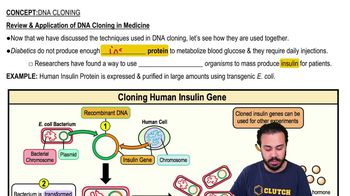Table of contents
- 1. Introduction to Biology2h 42m
- 2. Chemistry3h 40m
- 3. Water1h 26m
- 4. Biomolecules2h 23m
- 5. Cell Components2h 26m
- 6. The Membrane2h 31m
- 7. Energy and Metabolism2h 0m
- 8. Respiration2h 40m
- 9. Photosynthesis2h 49m
- 10. Cell Signaling59m
- 11. Cell Division2h 47m
- 12. Meiosis2h 0m
- 13. Mendelian Genetics4h 44m
- Introduction to Mendel's Experiments7m
- Genotype vs. Phenotype17m
- Punnett Squares13m
- Mendel's Experiments26m
- Mendel's Laws18m
- Monohybrid Crosses19m
- Test Crosses14m
- Dihybrid Crosses20m
- Punnett Square Probability26m
- Incomplete Dominance vs. Codominance20m
- Epistasis7m
- Non-Mendelian Genetics12m
- Pedigrees6m
- Autosomal Inheritance21m
- Sex-Linked Inheritance43m
- X-Inactivation9m
- 14. DNA Synthesis2h 27m
- 15. Gene Expression3h 20m
- 16. Regulation of Expression3h 31m
- Introduction to Regulation of Gene Expression13m
- Prokaryotic Gene Regulation via Operons27m
- The Lac Operon21m
- Glucose's Impact on Lac Operon25m
- The Trp Operon20m
- Review of the Lac Operon & Trp Operon11m
- Introduction to Eukaryotic Gene Regulation9m
- Eukaryotic Chromatin Modifications16m
- Eukaryotic Transcriptional Control22m
- Eukaryotic Post-Transcriptional Regulation28m
- Eukaryotic Post-Translational Regulation13m
- 17. Viruses37m
- 18. Biotechnology2h 58m
- 19. Genomics17m
- 20. Development1h 5m
- 21. Evolution3h 1m
- 22. Evolution of Populations3h 52m
- 23. Speciation1h 37m
- 24. History of Life on Earth2h 6m
- 25. Phylogeny2h 31m
- 26. Prokaryotes4h 59m
- 27. Protists1h 12m
- 28. Plants1h 22m
- 29. Fungi36m
- 30. Overview of Animals34m
- 31. Invertebrates1h 2m
- 32. Vertebrates50m
- 33. Plant Anatomy1h 3m
- 34. Vascular Plant Transport1h 2m
- 35. Soil37m
- 36. Plant Reproduction47m
- 37. Plant Sensation and Response1h 9m
- 38. Animal Form and Function1h 19m
- 39. Digestive System1h 10m
- 40. Circulatory System1h 57m
- 41. Immune System1h 12m
- 42. Osmoregulation and Excretion50m
- 43. Endocrine System1h 4m
- 44. Animal Reproduction1h 2m
- 45. Nervous System1h 55m
- 46. Sensory Systems46m
- 47. Muscle Systems23m
- 48. Ecology3h 11m
- Introduction to Ecology20m
- Biogeography14m
- Earth's Climate Patterns50m
- Introduction to Terrestrial Biomes10m
- Terrestrial Biomes: Near Equator13m
- Terrestrial Biomes: Temperate Regions10m
- Terrestrial Biomes: Northern Regions15m
- Introduction to Aquatic Biomes27m
- Freshwater Aquatic Biomes14m
- Marine Aquatic Biomes13m
- 49. Animal Behavior28m
- 50. Population Ecology3h 41m
- Introduction to Population Ecology28m
- Population Sampling Methods23m
- Life History12m
- Population Demography17m
- Factors Limiting Population Growth14m
- Introduction to Population Growth Models22m
- Linear Population Growth6m
- Exponential Population Growth29m
- Logistic Population Growth32m
- r/K Selection10m
- The Human Population22m
- 51. Community Ecology2h 46m
- Introduction to Community Ecology2m
- Introduction to Community Interactions9m
- Community Interactions: Competition (-/-)38m
- Community Interactions: Exploitation (+/-)23m
- Community Interactions: Mutualism (+/+) & Commensalism (+/0)9m
- Community Structure35m
- Community Dynamics26m
- Geographic Impact on Communities21m
- 52. Ecosystems2h 36m
- 53. Conservation Biology24m
18. Biotechnology
Introduction to DNA-Based Technology
Problem 3`
Textbook Question
'Bt maize'
a. Is resistant to various herbicides, making it practical to weed rice fields with those herbicides.
b. Contains transgenes that increase vitamin A content.
c. Includes bacterial genes that produce a toxin that reduces damage from insect pests.
d. Is a 'boron (B)-tolerant' transgenic variety of maize.
 Verified step by step guidance
Verified step by step guidance1
Understand the term 'Bt maize': Bt maize is a genetically modified organism (GMO) that has been engineered to express certain traits beneficial for agriculture.
Identify the source of the 'Bt' in Bt maize: The 'Bt' stands for Bacillus thuringiensis, a bacterium whose genes are used in the modification process.
Recognize the purpose of the Bt gene: The gene from Bacillus thuringiensis produces a protein that acts as an insecticide, protecting the maize from certain insect pests.
Evaluate the options given: Consider each option and determine which one correctly describes the characteristic of Bt maize.
Conclude with the correct characteristic: Bt maize is known for its ability to produce a toxin that reduces damage from insect pests, aligning with option c.
 Verified video answer for a similar problem:
Verified video answer for a similar problem:This video solution was recommended by our tutors as helpful for the problem above
Video duration:
1mPlay a video:
Was this helpful?
Key Concepts
Here are the essential concepts you must grasp in order to answer the question correctly.
Genetically Modified Organisms (GMOs)
Genetically Modified Organisms (GMOs) are organisms whose genetic material has been altered using genetic engineering techniques. In agriculture, GMOs are often developed to enhance resistance to pests, diseases, or environmental conditions, improve nutritional content, or increase crop yield. Bt maize is a type of GMO that includes genes from the bacterium Bacillus thuringiensis, which produce proteins toxic to certain insect pests.
Recommended video:
Guided course

Organization of DNA in the Cell
Bacillus thuringiensis (Bt)
Bacillus thuringiensis (Bt) is a bacterium that naturally produces proteins toxic to specific insects, particularly those in the order Lepidoptera, which includes many common pests. These proteins, known as Bt toxins, are used in agriculture to protect crops from insect damage. Bt maize is engineered to express these proteins, providing built-in pest resistance and reducing the need for chemical insecticides.
Recommended video:
Guided course

Endospores
Transgenic Crops
Transgenic crops are plants that have been genetically engineered to contain one or more genes from another species. These genes, known as transgenes, can confer beneficial traits such as pest resistance, herbicide tolerance, or enhanced nutritional content. Bt maize is a transgenic crop that contains bacterial genes enabling it to produce insecticidal proteins, thereby reducing crop damage and improving yield.
Recommended video:
Guided course

Review & Application of DNA Cloning in Medicine

 2:30m
2:30mWatch next
Master Introduction to DNA-Based Technology with a bite sized video explanation from Jason
Start learningRelated Videos
Related Practice











